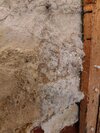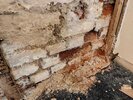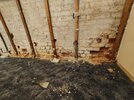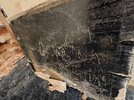The thread title doesn't do this justice, by far!
We've lived here for 25 years, the flat is a basement of an 1860's victorian terrace and was converted back in the 1980's. It was obviously whitewashed bare brick before so the "developer" battened and plasterboarded every internal wall. The floors are screeded and we don't know what is beneath, probably brick and no damp course.
Anyway; we've had the bottom of the walls in the living room blowing the plasterboard so we've decided to rip it out and have a look.
The cause of the blowing is spalled brick dust and it's several inches deep. The battens are, surprisingly, in pretty good condition although some have rotted at the bottom. The lower plasterboard panels have been painted with black bitumen (I think).
Main issue is, many of the lower bricks - up to about 5 or 6 courses - are badly spalled (but there's also a kind of furry coating in one place that as far as I can see isn't fungal but crystalline). See pics for what I mean.
Anyhow - what's the best way to proceed? I'm going to clear up the loose dust and brush down the brickwork and probably replace the battens, but do I use a masonry sealer or should I get the bricks replaced somehow (I think the wall in the pics is a supporting wall)? Should I go ahead with wood or galvanised steel battening?
The stuff on the back of the black-coated panels in the pic is spider web not fungal.
The nuclear option of "cover it up and move" is not feasible unfortunately!
Cheers
Malc
We've lived here for 25 years, the flat is a basement of an 1860's victorian terrace and was converted back in the 1980's. It was obviously whitewashed bare brick before so the "developer" battened and plasterboarded every internal wall. The floors are screeded and we don't know what is beneath, probably brick and no damp course.
Anyway; we've had the bottom of the walls in the living room blowing the plasterboard so we've decided to rip it out and have a look.
The cause of the blowing is spalled brick dust and it's several inches deep. The battens are, surprisingly, in pretty good condition although some have rotted at the bottom. The lower plasterboard panels have been painted with black bitumen (I think).
Main issue is, many of the lower bricks - up to about 5 or 6 courses - are badly spalled (but there's also a kind of furry coating in one place that as far as I can see isn't fungal but crystalline). See pics for what I mean.
Anyhow - what's the best way to proceed? I'm going to clear up the loose dust and brush down the brickwork and probably replace the battens, but do I use a masonry sealer or should I get the bricks replaced somehow (I think the wall in the pics is a supporting wall)? Should I go ahead with wood or galvanised steel battening?
The stuff on the back of the black-coated panels in the pic is spider web not fungal.
The nuclear option of "cover it up and move" is not feasible unfortunately!
Cheers
Malc





